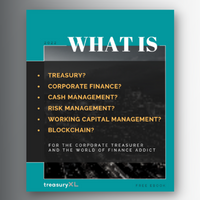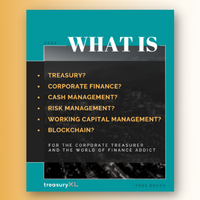 https://treasuryxl.com/wp-content/uploads/2024/07/Aviva-BLOGS-featured-8.png
200
200
treasuryXL
https://treasuryxl.com/wp-content/uploads/2018/07/treasuryXL-logo-300x56.png
treasuryXL2025-08-26 07:00:472025-08-22 12:24:50How Treasurers Manage Cash When It Matters Most
https://treasuryxl.com/wp-content/uploads/2024/07/Aviva-BLOGS-featured-8.png
200
200
treasuryXL
https://treasuryxl.com/wp-content/uploads/2018/07/treasuryXL-logo-300x56.png
treasuryXL2025-08-26 07:00:472025-08-22 12:24:50How Treasurers Manage Cash When It Matters MostInterest rate risk refers to the potential for financial losses arising from fluctuations in interest rates. It impacts the value of fixed-income securities (e.g., bonds), borrowing costs, and corporate profitability. For example, when rates rise, bond prices fall, and vice versa, due to the inverse relationship between rates and fixed-income asset values. This risk is particularly critical for entities with long-term debt, variable-rate loans, or investments sensitive to rate changes.
Key Drivers:
- Inverse Bond-Rate Relationship: A 10-year bond with a duration of ~8 will see its price drop by approximately 8% for every 1% increase in rates, assuming no convexity effects.
- Opportunity Cost: Investors may abandon low-yield bonds for higher-rate alternatives, triggering price declines.
Types and Examples of Interest Rate Risk
- Repricing Risk
Mismatches between asset and liability repricing timelines. Example: A bank with short-term deposits funding long-term loans faces losses if rates rise because its funding costs increase while loan interest rates remain fixed. - Yield Curve Risk
Changes in the yield curve’s shape (e.g., flattening) alter the relative value of assets/liabilities. For instance, If the yield curve flattens or inverts, banks may struggle to generate profits from traditional lending, as short-term borrowing costs approach or exceed long-term lending rates. - Basis Risk
Occurs when hedges and exposures use different reference rates. A company hedging SOFR-linked debt with LIBOR-based swaps may face losses if the rates diverge, making the hedge less effective and increasing financing costs. - Optionality Risk
Embedded options (e.g., callable bonds) create uncertainty. If rates drop, borrowers may refinance debt, leaving lenders with lower returns and reinvestment risk at lower interest rates.
Real-World Example:
A company with a $10M loan at SOFR + 3% interest is exposed to rate fluctuations. If SOFR rises significantly, its interest payments increase. Hedging via an interest rate swap (fixed 7%) could save $400K annually if SOFR hits 11%, effectively capping its borrowing costs.
Managing Interest Rate Risk
1. Hedging Strategies
- Interest Rate Swaps: Exchange floating-rate payments for fixed rates (or vice versa) to stabilize cash flows.
- Caps/Floors: Limit maximum rates (caps) or set minimum returns (floors). A cap at 9% protects against SOFR spikes, while a floor at 5% safeguards investments.
- Collars: Combine caps and floors for zero-cost protection within a rate range.
2. Diversification & Duration Matching
- Bond Laddering: Stagger maturities to balance reinvestment risk and liquidity 13.
- Duration Analysis: Align asset/liability durations to minimize sensitivity. A 10-year bond’s price drops more sharply than a 1-year bond’s if rates rise.
3. Advanced Risk Measurement
- Scenario Analysis: Model rate shocks (e.g., +200 bps) to assess cash flow and balance sheet impacts.
- Value-at-Risk (VaR): Quantify potential losses under extreme rate movements
4. Regulatory Compliance
The Basel III framework mandates rigorous IRRBB (Interest Rate Risk in the Banking Book) testing, including gap analysis and stress simulations to ensure financial institutions are prepared for rate volatility.
Relevance for Corporate Treasury
Treasury teams play an important role in mitigating interest rate risk through:
- Centralized Liquidity Management: Optimize cash visibility and automate sweeps to reduce funding costs.
- Dynamic Hedging: Use AI-driven prepayment models and real-time data to adjust derivatives portfolios.
- Stress Testing: Integrate rate, liquidity, and credit risks into forecasts. For example, McKinsey notes that top-performing banks reduced interest expenses by 70% through advanced modeling.
Conclusion
Interest rate risk is a multifaceted challenge requiring proactive management. By leveraging derivatives, scenario planning, and regulatory alignment, treasurers can transform volatility into strategic advantage. As rates remain unpredictable, institutions must prioritize agility, data granularity, and cross-functional collaboration to safeguard financial stability.
Click and Scroll! Here are more articles that you might like…
 https://treasuryxl.com/wp-content/uploads/2024/07/Aviva-BLOGS-featured-8.png
200
200
treasuryXL
https://treasuryxl.com/wp-content/uploads/2018/07/treasuryXL-logo-300x56.png
treasuryXL2025-08-26 07:00:472025-08-22 12:24:50How Treasurers Manage Cash When It Matters Most
https://treasuryxl.com/wp-content/uploads/2024/07/Aviva-BLOGS-featured-8.png
200
200
treasuryXL
https://treasuryxl.com/wp-content/uploads/2018/07/treasuryXL-logo-300x56.png
treasuryXL2025-08-26 07:00:472025-08-22 12:24:50How Treasurers Manage Cash When It Matters Most https://treasuryxl.com/wp-content/uploads/2025/05/Live-Session-TreasurySpring-200-3.png
200
200
treasuryXL
https://treasuryxl.com/wp-content/uploads/2018/07/treasuryXL-logo-300x56.png
treasuryXL2025-05-12 07:00:542025-05-08 14:57:36Recap & Recording: How To Find High Ground When The Waters Are Rising
https://treasuryxl.com/wp-content/uploads/2025/05/Live-Session-TreasurySpring-200-3.png
200
200
treasuryXL
https://treasuryxl.com/wp-content/uploads/2018/07/treasuryXL-logo-300x56.png
treasuryXL2025-05-12 07:00:542025-05-08 14:57:36Recap & Recording: How To Find High Ground When The Waters Are Rising https://treasuryxl.com/wp-content/uploads/2025/04/Live-Session-TreasurySpring-200-2.png
200
200
treasuryXL
https://treasuryxl.com/wp-content/uploads/2018/07/treasuryXL-logo-300x56.png
treasuryXL2025-04-30 13:08:112025-05-07 16:16:43Live Session: How To Find High Ground When The Waters Are Rising
https://treasuryxl.com/wp-content/uploads/2025/04/Live-Session-TreasurySpring-200-2.png
200
200
treasuryXL
https://treasuryxl.com/wp-content/uploads/2018/07/treasuryXL-logo-300x56.png
treasuryXL2025-04-30 13:08:112025-05-07 16:16:43Live Session: How To Find High Ground When The Waters Are Rising https://treasuryxl.com/wp-content/uploads/2025/04/Eugene-Template_BLOGS-Expert-featured-1.png
200
200
treasuryXL
https://treasuryxl.com/wp-content/uploads/2018/07/treasuryXL-logo-300x56.png
treasuryXL2025-04-28 07:00:072025-04-25 14:24:31Mastering Treasury: Hedging, FX, Cash Management & More
https://treasuryxl.com/wp-content/uploads/2025/04/Eugene-Template_BLOGS-Expert-featured-1.png
200
200
treasuryXL
https://treasuryxl.com/wp-content/uploads/2018/07/treasuryXL-logo-300x56.png
treasuryXL2025-04-28 07:00:072025-04-25 14:24:31Mastering Treasury: Hedging, FX, Cash Management & More https://treasuryxl.com/wp-content/uploads/2025/03/Aviva-BLOGS-featured-5.png
200
200
treasuryXL
https://treasuryxl.com/wp-content/uploads/2018/07/treasuryXL-logo-300x56.png
treasuryXL2025-03-10 07:00:212025-04-24 17:19:48Liquidity Management in Treasury: Understanding and Balancing Liquidity with Investment Opportunities
https://treasuryxl.com/wp-content/uploads/2025/03/Aviva-BLOGS-featured-5.png
200
200
treasuryXL
https://treasuryxl.com/wp-content/uploads/2018/07/treasuryXL-logo-300x56.png
treasuryXL2025-03-10 07:00:212025-04-24 17:19:48Liquidity Management in Treasury: Understanding and Balancing Liquidity with Investment Opportunities https://treasuryxl.com/wp-content/uploads/2025/02/LIVE-SESSION-1.png
200
200
treasuryXL
https://treasuryxl.com/wp-content/uploads/2018/07/treasuryXL-logo-300x56.png
treasuryXL2025-02-14 10:00:102025-02-13 16:25:36Recap & Recording: How to Boost Your Revenue and Protect Margins with Treasury Solutions
https://treasuryxl.com/wp-content/uploads/2025/02/LIVE-SESSION-1.png
200
200
treasuryXL
https://treasuryxl.com/wp-content/uploads/2018/07/treasuryXL-logo-300x56.png
treasuryXL2025-02-14 10:00:102025-02-13 16:25:36Recap & Recording: How to Boost Your Revenue and Protect Margins with Treasury Solutions https://treasuryxl.com/wp-content/uploads/2024/08/Aviva-BLOGS-featured-2.png
200
200
treasuryXL
https://treasuryxl.com/wp-content/uploads/2018/07/treasuryXL-logo-300x56.png
treasuryXL2025-02-04 07:00:032025-02-04 08:51:31Liquidity outlook for 2025
https://treasuryxl.com/wp-content/uploads/2024/08/Aviva-BLOGS-featured-2.png
200
200
treasuryXL
https://treasuryxl.com/wp-content/uploads/2018/07/treasuryXL-logo-300x56.png
treasuryXL2025-02-04 07:00:032025-02-04 08:51:31Liquidity outlook for 2025 https://treasuryxl.com/wp-content/uploads/2025/01/LIVE-SESSION-Kantox-Recap.png
200
200
treasuryXL
https://treasuryxl.com/wp-content/uploads/2018/07/treasuryXL-logo-300x56.png
treasuryXL2025-01-24 10:04:242025-01-24 10:05:11Recap & Recording: Your Currency Management Toolkit for 2025
https://treasuryxl.com/wp-content/uploads/2025/01/LIVE-SESSION-Kantox-Recap.png
200
200
treasuryXL
https://treasuryxl.com/wp-content/uploads/2018/07/treasuryXL-logo-300x56.png
treasuryXL2025-01-24 10:04:242025-01-24 10:05:11Recap & Recording: Your Currency Management Toolkit for 2025 https://treasuryxl.com/wp-content/uploads/2025/01/LIVE-SESSION-Kantox-1.png
200
200
treasuryXL
https://treasuryxl.com/wp-content/uploads/2018/07/treasuryXL-logo-300x56.png
treasuryXL2025-01-15 10:00:472025-01-15 13:17:15Live Session: Your Currency Management Toolkit for 2025
https://treasuryxl.com/wp-content/uploads/2025/01/LIVE-SESSION-Kantox-1.png
200
200
treasuryXL
https://treasuryxl.com/wp-content/uploads/2018/07/treasuryXL-logo-300x56.png
treasuryXL2025-01-15 10:00:472025-01-15 13:17:15Live Session: Your Currency Management Toolkit for 2025 https://treasuryxl.com/wp-content/uploads/2024/08/Bound-BLOGS-featured-1.png
200
200
treasuryXL
https://treasuryxl.com/wp-content/uploads/2018/07/treasuryXL-logo-300x56.png
treasuryXL2024-12-16 07:00:042024-12-13 10:52:26FX Hedging for Beginners: Reduce Foreign Currency Risk
https://treasuryxl.com/wp-content/uploads/2024/08/Bound-BLOGS-featured-1.png
200
200
treasuryXL
https://treasuryxl.com/wp-content/uploads/2018/07/treasuryXL-logo-300x56.png
treasuryXL2024-12-16 07:00:042024-12-13 10:52:26FX Hedging for Beginners: Reduce Foreign Currency Risk https://treasuryxl.com/wp-content/uploads/2024/11/Jennifer-featured.png
200
200
treasuryXL
https://treasuryxl.com/wp-content/uploads/2018/07/treasuryXL-logo-300x56.png
treasuryXL2024-11-11 10:00:042024-11-26 11:20:34How treasurers should respond to the US election!
https://treasuryxl.com/wp-content/uploads/2024/11/Jennifer-featured.png
200
200
treasuryXL
https://treasuryxl.com/wp-content/uploads/2018/07/treasuryXL-logo-300x56.png
treasuryXL2024-11-11 10:00:042024-11-26 11:20:34How treasurers should respond to the US election! https://treasuryxl.com/wp-content/uploads/2024/08/Bound-BLOGS-featured-1.png
200
200
treasuryXL
https://treasuryxl.com/wp-content/uploads/2018/07/treasuryXL-logo-300x56.png
treasuryXL2024-11-11 07:00:532024-11-07 09:03:56Two sides of one coin: Hedging vs. Speculation
https://treasuryxl.com/wp-content/uploads/2024/08/Bound-BLOGS-featured-1.png
200
200
treasuryXL
https://treasuryxl.com/wp-content/uploads/2018/07/treasuryXL-logo-300x56.png
treasuryXL2024-11-11 07:00:532024-11-07 09:03:56Two sides of one coin: Hedging vs. Speculation https://treasuryxl.com/wp-content/uploads/2024/07/Bound-BLOGS-featured.png
200
200
treasuryXL
https://treasuryxl.com/wp-content/uploads/2018/07/treasuryXL-logo-300x56.png
treasuryXL2024-11-05 07:00:202024-10-31 16:12:09FX: Is hedging expensive?
https://treasuryxl.com/wp-content/uploads/2024/07/Bound-BLOGS-featured.png
200
200
treasuryXL
https://treasuryxl.com/wp-content/uploads/2018/07/treasuryXL-logo-300x56.png
treasuryXL2024-11-05 07:00:202024-10-31 16:12:09FX: Is hedging expensive? https://treasuryxl.com/wp-content/uploads/2024/08/Bound-BLOGS-featured-1.png
200
200
treasuryXL
https://treasuryxl.com/wp-content/uploads/2018/07/treasuryXL-logo-300x56.png
treasuryXL2024-10-03 07:00:482024-09-30 15:17:08FX Hedging that is flexible enough for the real world
https://treasuryxl.com/wp-content/uploads/2024/08/Bound-BLOGS-featured-1.png
200
200
treasuryXL
https://treasuryxl.com/wp-content/uploads/2018/07/treasuryXL-logo-300x56.png
treasuryXL2024-10-03 07:00:482024-09-30 15:17:08FX Hedging that is flexible enough for the real world https://treasuryxl.com/wp-content/uploads/2024/07/Bound-BLOGS-featured.png
200
200
treasuryXL
https://treasuryxl.com/wp-content/uploads/2018/07/treasuryXL-logo-300x56.png
treasuryXL2024-09-17 07:00:412024-08-26 10:08:36Currency Markets: Hedgers, Capital Markets and Investors
https://treasuryxl.com/wp-content/uploads/2024/07/Bound-BLOGS-featured.png
200
200
treasuryXL
https://treasuryxl.com/wp-content/uploads/2018/07/treasuryXL-logo-300x56.png
treasuryXL2024-09-17 07:00:412024-08-26 10:08:36Currency Markets: Hedgers, Capital Markets and Investors https://treasuryxl.com/wp-content/uploads/2024/08/Aviva-BLOGS-featured-2.png
200
200
treasuryXL
https://treasuryxl.com/wp-content/uploads/2018/07/treasuryXL-logo-300x56.png
treasuryXL2024-09-16 07:00:572024-09-12 09:03:33Finding the right blend | Optimising asset allocation in liquidity pools
https://treasuryxl.com/wp-content/uploads/2024/08/Aviva-BLOGS-featured-2.png
200
200
treasuryXL
https://treasuryxl.com/wp-content/uploads/2018/07/treasuryXL-logo-300x56.png
treasuryXL2024-09-16 07:00:572024-09-12 09:03:33Finding the right blend | Optimising asset allocation in liquidity pools https://treasuryxl.com/wp-content/uploads/2024/09/Wout-Template_BLOGS-Expert-featured-1.png
200
200
treasuryXL
https://treasuryxl.com/wp-content/uploads/2018/07/treasuryXL-logo-300x56.png
treasuryXL2024-09-05 07:00:362025-04-24 17:16:18Growing Interest in Cashflow Management Software
https://treasuryxl.com/wp-content/uploads/2024/09/Wout-Template_BLOGS-Expert-featured-1.png
200
200
treasuryXL
https://treasuryxl.com/wp-content/uploads/2018/07/treasuryXL-logo-300x56.png
treasuryXL2024-09-05 07:00:362025-04-24 17:16:18Growing Interest in Cashflow Management Software https://treasuryxl.com/wp-content/uploads/2024/08/Aviva-BLOGS-featured-2.png
200
200
treasuryXL
https://treasuryxl.com/wp-content/uploads/2018/07/treasuryXL-logo-300x56.png
treasuryXL2024-08-29 07:00:482024-08-29 13:57:26How much Liquidity do I need?
https://treasuryxl.com/wp-content/uploads/2024/08/Aviva-BLOGS-featured-2.png
200
200
treasuryXL
https://treasuryxl.com/wp-content/uploads/2018/07/treasuryXL-logo-300x56.png
treasuryXL2024-08-29 07:00:482024-08-29 13:57:26How much Liquidity do I need? https://treasuryxl.com/wp-content/uploads/2024/08/Bound-BLOGS-featured-1.png
200
200
treasuryXL
https://treasuryxl.com/wp-content/uploads/2018/07/treasuryXL-logo-300x56.png
treasuryXL2024-08-27 07:00:552024-08-26 09:49:273 Step Plan to Mitigate FX Risks
https://treasuryxl.com/wp-content/uploads/2024/08/Bound-BLOGS-featured-1.png
200
200
treasuryXL
https://treasuryxl.com/wp-content/uploads/2018/07/treasuryXL-logo-300x56.png
treasuryXL2024-08-27 07:00:552024-08-26 09:49:273 Step Plan to Mitigate FX Risks https://treasuryxl.com/wp-content/uploads/2024/07/Bound-BLOGS-featured.png
200
200
treasuryXL
https://treasuryxl.com/wp-content/uploads/2018/07/treasuryXL-logo-300x56.png
treasuryXL2024-07-18 07:00:332024-07-15 10:49:51Where Are Foreign Exchange Rates Headed?
https://treasuryxl.com/wp-content/uploads/2024/07/Bound-BLOGS-featured.png
200
200
treasuryXL
https://treasuryxl.com/wp-content/uploads/2018/07/treasuryXL-logo-300x56.png
treasuryXL2024-07-18 07:00:332024-07-15 10:49:51Where Are Foreign Exchange Rates Headed? https://treasuryxl.com/wp-content/uploads/2024/07/Aviva-Investord.png
200
200
treasuryXL
https://treasuryxl.com/wp-content/uploads/2018/07/treasuryXL-logo-300x56.png
treasuryXL2024-07-17 07:00:522024-07-16 15:56:37treasuryXL and Aviva Investors announce Premium Partnership
https://treasuryxl.com/wp-content/uploads/2024/07/Aviva-Investord.png
200
200
treasuryXL
https://treasuryxl.com/wp-content/uploads/2018/07/treasuryXL-logo-300x56.png
treasuryXL2024-07-17 07:00:522024-07-16 15:56:37treasuryXL and Aviva Investors announce Premium Partnership https://treasuryxl.com/wp-content/uploads/2023/11/Treasury-Trends-2024.png
200
200
treasuryXL
https://treasuryxl.com/wp-content/uploads/2018/07/treasuryXL-logo-300x56.png
treasuryXL2023-11-15 07:30:142023-11-14 15:39:28Live Session | Treasury Trends for 2024
https://treasuryxl.com/wp-content/uploads/2023/11/Treasury-Trends-2024.png
200
200
treasuryXL
https://treasuryxl.com/wp-content/uploads/2018/07/treasuryXL-logo-300x56.png
treasuryXL2023-11-15 07:30:142023-11-14 15:39:28Live Session | Treasury Trends for 2024 https://treasuryxl.com/wp-content/uploads/2023/10/RECAP-Ebury.png
200
200
treasuryXL
https://treasuryxl.com/wp-content/uploads/2018/07/treasuryXL-logo-300x56.png
treasuryXL2023-10-12 07:00:582023-10-10 14:17:40Recap and Recording: Fluctuating Interest and Currency Markets: What to expect & do?
https://treasuryxl.com/wp-content/uploads/2023/10/RECAP-Ebury.png
200
200
treasuryXL
https://treasuryxl.com/wp-content/uploads/2018/07/treasuryXL-logo-300x56.png
treasuryXL2023-10-12 07:00:582023-10-10 14:17:40Recap and Recording: Fluctuating Interest and Currency Markets: What to expect & do? https://treasuryxl.com/wp-content/uploads/2023/08/Refintivi-blog-200-28e.png
200
200
treasuryXL
https://treasuryxl.com/wp-content/uploads/2018/07/treasuryXL-logo-300x56.png
treasuryXL2023-09-28 10:00:412023-09-28 11:21:15Revolutionising FX Price Transparency with Tick History – PCAP
https://treasuryxl.com/wp-content/uploads/2023/08/Refintivi-blog-200-28e.png
200
200
treasuryXL
https://treasuryxl.com/wp-content/uploads/2018/07/treasuryXL-logo-300x56.png
treasuryXL2023-09-28 10:00:412023-09-28 11:21:15Revolutionising FX Price Transparency with Tick History – PCAP https://treasuryxl.com/wp-content/uploads/2023/09/Sign-up-Ebury.png
200
200
treasuryXL
https://treasuryxl.com/wp-content/uploads/2018/07/treasuryXL-logo-300x56.png
treasuryXL2023-09-15 11:30:172023-10-04 16:13:29Live Session | Fluctuating Interest and Currency Markets: What to expect & do?
https://treasuryxl.com/wp-content/uploads/2023/09/Sign-up-Ebury.png
200
200
treasuryXL
https://treasuryxl.com/wp-content/uploads/2018/07/treasuryXL-logo-300x56.png
treasuryXL2023-09-15 11:30:172023-10-04 16:13:29Live Session | Fluctuating Interest and Currency Markets: What to expect & do? https://treasuryxl.com/wp-content/uploads/2023/09/LSEG-event.png
200
200
treasuryXL
https://treasuryxl.com/wp-content/uploads/2018/07/treasuryXL-logo-300x56.png
treasuryXL2023-09-11 07:15:172023-09-07 15:23:43Information, Integration and Innovation: The Cloud and Data Management Forum
https://treasuryxl.com/wp-content/uploads/2023/09/LSEG-event.png
200
200
treasuryXL
https://treasuryxl.com/wp-content/uploads/2018/07/treasuryXL-logo-300x56.png
treasuryXL2023-09-11 07:15:172023-09-07 15:23:43Information, Integration and Innovation: The Cloud and Data Management Forum https://treasuryxl.com/wp-content/uploads/2023/08/Poll-results-13.png
200
200
treasuryXL
https://treasuryxl.com/wp-content/uploads/2018/07/treasuryXL-logo-300x56.png
treasuryXL2023-08-22 12:00:412023-08-28 13:52:30Which Solution would enhance the Safety and Security of Financial Processes?
https://treasuryxl.com/wp-content/uploads/2023/08/Poll-results-13.png
200
200
treasuryXL
https://treasuryxl.com/wp-content/uploads/2018/07/treasuryXL-logo-300x56.png
treasuryXL2023-08-22 12:00:412023-08-28 13:52:30Which Solution would enhance the Safety and Security of Financial Processes? https://treasuryxl.com/wp-content/uploads/2023/08/Sabbir-200.png
200
200
treasuryXL
https://treasuryxl.com/wp-content/uploads/2018/07/treasuryXL-logo-300x56.png
treasuryXL2023-08-14 07:00:542023-11-01 10:42:15The Benefits and Challenges of Project Finance
https://treasuryxl.com/wp-content/uploads/2023/08/Sabbir-200.png
200
200
treasuryXL
https://treasuryxl.com/wp-content/uploads/2018/07/treasuryXL-logo-300x56.png
treasuryXL2023-08-14 07:00:542023-11-01 10:42:15The Benefits and Challenges of Project Finance https://treasuryxl.com/wp-content/uploads/2023/08/Francois-training-200.png
200
200
treasuryXL
https://treasuryxl.com/wp-content/uploads/2018/07/treasuryXL-logo-300x56.png
treasuryXL2023-08-09 07:00:432023-08-07 09:57:37New International Treasury Management and Corporate Finance Fundamentals programme starting
https://treasuryxl.com/wp-content/uploads/2023/08/Francois-training-200.png
200
200
treasuryXL
https://treasuryxl.com/wp-content/uploads/2018/07/treasuryXL-logo-300x56.png
treasuryXL2023-08-09 07:00:432023-08-07 09:57:37New International Treasury Management and Corporate Finance Fundamentals programme starting https://treasuryxl.com/wp-content/uploads/2023/07/Poll-results-12.png
200
200
treasuryXL
https://treasuryxl.com/wp-content/uploads/2018/07/treasuryXL-logo-300x56.png
treasuryXL2023-07-27 16:25:512023-07-28 09:15:40How to Adjust Your Working Capital Management in a Changing Economy
https://treasuryxl.com/wp-content/uploads/2023/07/Poll-results-12.png
200
200
treasuryXL
https://treasuryxl.com/wp-content/uploads/2018/07/treasuryXL-logo-300x56.png
treasuryXL2023-07-27 16:25:512023-07-28 09:15:40How to Adjust Your Working Capital Management in a Changing Economy https://treasuryxl.com/wp-content/uploads/2023/07/Refinitiv-Webinar-200.png
200
200
treasuryXL
https://treasuryxl.com/wp-content/uploads/2018/07/treasuryXL-logo-300x56.png
treasuryXL2023-07-13 07:00:572023-07-12 11:32:24Webinar on demand | Corporate Treasury: Managing and Hedging Corporate Risk
https://treasuryxl.com/wp-content/uploads/2023/07/Refinitiv-Webinar-200.png
200
200
treasuryXL
https://treasuryxl.com/wp-content/uploads/2018/07/treasuryXL-logo-300x56.png
treasuryXL2023-07-13 07:00:572023-07-12 11:32:24Webinar on demand | Corporate Treasury: Managing and Hedging Corporate Risk https://treasuryxl.com/wp-content/uploads/2023/06/Symbology-200.png
200
200
treasuryXL
https://treasuryxl.com/wp-content/uploads/2018/07/treasuryXL-logo-300x56.png
treasuryXL2023-06-15 07:00:102023-06-19 14:22:48How can symbology transform the trade life cycle?
https://treasuryxl.com/wp-content/uploads/2023/06/Symbology-200.png
200
200
treasuryXL
https://treasuryxl.com/wp-content/uploads/2018/07/treasuryXL-logo-300x56.png
treasuryXL2023-06-15 07:00:102023-06-19 14:22:48How can symbology transform the trade life cycle? https://treasuryxl.com/wp-content/uploads/2023/06/Refinitiv-200-1.png
200
200
treasuryXL
https://treasuryxl.com/wp-content/uploads/2018/07/treasuryXL-logo-300x56.png
treasuryXL2023-06-07 07:00:002023-06-12 16:41:15eBook | Optimizing Fixed Income Strategies: Market Trends and Risk Mitigation
https://treasuryxl.com/wp-content/uploads/2023/06/Refinitiv-200-1.png
200
200
treasuryXL
https://treasuryxl.com/wp-content/uploads/2018/07/treasuryXL-logo-300x56.png
treasuryXL2023-06-07 07:00:002023-06-12 16:41:15eBook | Optimizing Fixed Income Strategies: Market Trends and Risk Mitigation https://treasuryxl.com/wp-content/uploads/2023/04/blog-sabbir-200.png
200
200
treasuryXL
https://treasuryxl.com/wp-content/uploads/2018/07/treasuryXL-logo-300x56.png
treasuryXL2023-04-26 07:00:472023-04-26 11:14:29The differences between Senior Secured and Senior Unsecured Debt
https://treasuryxl.com/wp-content/uploads/2023/04/blog-sabbir-200.png
200
200
treasuryXL
https://treasuryxl.com/wp-content/uploads/2018/07/treasuryXL-logo-300x56.png
treasuryXL2023-04-26 07:00:472023-04-26 11:14:29The differences between Senior Secured and Senior Unsecured Debt https://treasuryxl.com/wp-content/uploads/2022/05/eBook-gray.png
200
200
treasuryXL
https://treasuryxl.com/wp-content/uploads/2018/07/treasuryXL-logo-300x56.png
treasuryXL2023-02-23 08:00:492023-02-21 14:21:19Unlock Your Treasury Expertise Today – Download Our Free eBook!
https://treasuryxl.com/wp-content/uploads/2022/05/eBook-gray.png
200
200
treasuryXL
https://treasuryxl.com/wp-content/uploads/2018/07/treasuryXL-logo-300x56.png
treasuryXL2023-02-23 08:00:492023-02-21 14:21:19Unlock Your Treasury Expertise Today – Download Our Free eBook! https://treasuryxl.com/wp-content/uploads/2023/02/unlock-200x200-1.png
200
200
treasuryXL
https://treasuryxl.com/wp-content/uploads/2018/07/treasuryXL-logo-300x56.png
treasuryXL2023-02-14 07:00:082023-04-06 09:55:32LIVE SESSION | Unlock the Benefits of Interim Treasury Management
https://treasuryxl.com/wp-content/uploads/2023/02/unlock-200x200-1.png
200
200
treasuryXL
https://treasuryxl.com/wp-content/uploads/2018/07/treasuryXL-logo-300x56.png
treasuryXL2023-02-14 07:00:082023-04-06 09:55:32LIVE SESSION | Unlock the Benefits of Interim Treasury Management https://treasuryxl.com/wp-content/uploads/2023/02/eurofinance-200.png
200
200
treasuryXL
https://treasuryxl.com/wp-content/uploads/2018/07/treasuryXL-logo-300x56.png
treasuryXL2023-02-07 07:00:202023-02-06 10:33:56Effective Finance & Treasury in Africa | Eurofinance
https://treasuryxl.com/wp-content/uploads/2023/02/eurofinance-200.png
200
200
treasuryXL
https://treasuryxl.com/wp-content/uploads/2018/07/treasuryXL-logo-300x56.png
treasuryXL2023-02-07 07:00:202023-02-06 10:33:56Effective Finance & Treasury in Africa | Eurofinance https://treasuryxl.com/wp-content/uploads/2022/12/Kopie-van-linkedin-poll-5-200-2.png
200
200
treasuryXL
https://treasuryxl.com/wp-content/uploads/2018/07/treasuryXL-logo-300x56.png
treasuryXL2022-11-30 12:00:342023-02-02 12:58:41What will be the Treasury Trend of 2023?
https://treasuryxl.com/wp-content/uploads/2022/12/Kopie-van-linkedin-poll-5-200-2.png
200
200
treasuryXL
https://treasuryxl.com/wp-content/uploads/2018/07/treasuryXL-logo-300x56.png
treasuryXL2022-11-30 12:00:342023-02-02 12:58:41What will be the Treasury Trend of 2023? https://treasuryxl.com/wp-content/uploads/2022/05/eBook-gray.png
200
200
treasuryXL
https://treasuryxl.com/wp-content/uploads/2018/07/treasuryXL-logo-300x56.png
treasuryXL2022-10-27 10:20:362022-10-27 10:29:22Brush up on your treasury knowledge? Get our eBook: What is Treasury?
https://treasuryxl.com/wp-content/uploads/2022/05/eBook-gray.png
200
200
treasuryXL
https://treasuryxl.com/wp-content/uploads/2018/07/treasuryXL-logo-300x56.png
treasuryXL2022-10-27 10:20:362022-10-27 10:29:22Brush up on your treasury knowledge? Get our eBook: What is Treasury? https://treasuryxl.com/wp-content/uploads/2022/10/Pieter-Vienna.png
200
200
treasuryXL
https://treasuryxl.com/wp-content/uploads/2018/07/treasuryXL-logo-300x56.png
treasuryXL2022-10-12 14:42:432023-01-02 14:17:36Eurofinance remains THE event for corporate treasurers | By Pieter de Kiewit
https://treasuryxl.com/wp-content/uploads/2022/10/Pieter-Vienna.png
200
200
treasuryXL
https://treasuryxl.com/wp-content/uploads/2018/07/treasuryXL-logo-300x56.png
treasuryXL2022-10-12 14:42:432023-01-02 14:17:36Eurofinance remains THE event for corporate treasurers | By Pieter de Kiewit https://treasuryxl.com/wp-content/uploads/2022/09/WEBINAR.png
200
200
treasuryXL
https://treasuryxl.com/wp-content/uploads/2018/07/treasuryXL-logo-300x56.png
treasuryXL2022-09-29 07:00:452023-01-02 14:17:59LIVE SESSION | My Treasury Career Development & How the Register Treasurer education contributed
https://treasuryxl.com/wp-content/uploads/2022/09/WEBINAR.png
200
200
treasuryXL
https://treasuryxl.com/wp-content/uploads/2018/07/treasuryXL-logo-300x56.png
treasuryXL2022-09-29 07:00:452023-01-02 14:17:59LIVE SESSION | My Treasury Career Development & How the Register Treasurer education contributed https://treasuryxl.com/wp-content/uploads/2022/09/blog-pieter-19e-200.png
200
200
treasuryXL
https://treasuryxl.com/wp-content/uploads/2018/07/treasuryXL-logo-300x56.png
treasuryXL2022-09-19 07:00:032023-01-02 14:18:20Where did the treasury applicants go? | By Pieter de Kiewit
https://treasuryxl.com/wp-content/uploads/2022/09/blog-pieter-19e-200.png
200
200
treasuryXL
https://treasuryxl.com/wp-content/uploads/2018/07/treasuryXL-logo-300x56.png
treasuryXL2022-09-19 07:00:032023-01-02 14:18:20Where did the treasury applicants go? | By Pieter de Kiewit https://treasuryxl.com/wp-content/uploads/2022/05/eBook-gray.png
200
200
treasuryXL
https://treasuryxl.com/wp-content/uploads/2018/07/treasuryXL-logo-300x56.png
treasuryXL2022-09-08 11:40:442022-09-08 11:59:28Quickly refresh your treasury knowledge? Download our eBook: What is Treasury?
https://treasuryxl.com/wp-content/uploads/2022/05/eBook-gray.png
200
200
treasuryXL
https://treasuryxl.com/wp-content/uploads/2018/07/treasuryXL-logo-300x56.png
treasuryXL2022-09-08 11:40:442022-09-08 11:59:28Quickly refresh your treasury knowledge? Download our eBook: What is Treasury? https://treasuryxl.com/wp-content/uploads/2022/09/Cash-and-Treasurer-featured-200x200-1.png
200
200
treasuryXL
https://treasuryxl.com/wp-content/uploads/2018/07/treasuryXL-logo-300x56.png
treasuryXL2022-09-06 11:00:102022-09-06 12:46:51RECAP | Cash and Treasury Management Event Copenhagen | By Pieter de Kiewit
https://treasuryxl.com/wp-content/uploads/2022/09/Cash-and-Treasurer-featured-200x200-1.png
200
200
treasuryXL
https://treasuryxl.com/wp-content/uploads/2018/07/treasuryXL-logo-300x56.png
treasuryXL2022-09-06 11:00:102022-09-06 12:46:51RECAP | Cash and Treasury Management Event Copenhagen | By Pieter de Kiewit https://treasuryxl.com/wp-content/uploads/2022/08/22cash-featured-200x200px4.jpg
200
200
treasuryXL
https://treasuryxl.com/wp-content/uploads/2018/07/treasuryXL-logo-300x56.png
treasuryXL2022-08-04 09:21:162022-08-04 09:21:16Cash & Treasury Management: Join The World’s Leading Experts in Copenhagen
https://treasuryxl.com/wp-content/uploads/2022/08/22cash-featured-200x200px4.jpg
200
200
treasuryXL
https://treasuryxl.com/wp-content/uploads/2018/07/treasuryXL-logo-300x56.png
treasuryXL2022-08-04 09:21:162022-08-04 09:21:16Cash & Treasury Management: Join The World’s Leading Experts in Copenhagen https://treasuryxl.com/wp-content/uploads/2022/07/cxc-200-13e.png
200
200
treasuryXL
https://treasuryxl.com/wp-content/uploads/2018/07/treasuryXL-logo-300x56.png
treasuryXL2022-07-13 07:00:582022-07-08 09:08:17Approaches to FX Volatility
https://treasuryxl.com/wp-content/uploads/2022/07/cxc-200-13e.png
200
200
treasuryXL
https://treasuryxl.com/wp-content/uploads/2018/07/treasuryXL-logo-300x56.png
treasuryXL2022-07-13 07:00:582022-07-08 09:08:17Approaches to FX Volatility https://treasuryxl.com/wp-content/uploads/2022/06/Kopie-van-cxc-200.png
200
200
treasuryXL
https://treasuryxl.com/wp-content/uploads/2018/07/treasuryXL-logo-300x56.png
treasuryXL2022-06-20 07:00:502022-06-15 13:29:18Treasury & Banking in India
https://treasuryxl.com/wp-content/uploads/2022/06/Kopie-van-cxc-200.png
200
200
treasuryXL
https://treasuryxl.com/wp-content/uploads/2018/07/treasuryXL-logo-300x56.png
treasuryXL2022-06-20 07:00:502022-06-15 13:29:18Treasury & Banking in India https://treasuryxl.com/wp-content/uploads/2022/06/treasuryXL-200x200-1.jpg
200
200
treasuryXL
https://treasuryxl.com/wp-content/uploads/2018/07/treasuryXL-logo-300x56.png
treasuryXL2022-06-13 07:00:552022-06-10 11:50:23Treasury in transition – explore the agenda for EuroFinance International Treasury Management
https://treasuryxl.com/wp-content/uploads/2022/06/treasuryXL-200x200-1.jpg
200
200
treasuryXL
https://treasuryxl.com/wp-content/uploads/2018/07/treasuryXL-logo-300x56.png
treasuryXL2022-06-13 07:00:552022-06-10 11:50:23Treasury in transition – explore the agenda for EuroFinance International Treasury Management https://treasuryxl.com/wp-content/uploads/2022/05/eBook-gray.png
200
200
treasuryXL
https://treasuryxl.com/wp-content/uploads/2018/07/treasuryXL-logo-300x56.png
treasuryXL2022-05-16 07:00:382022-08-15 14:52:05Subscribe and receive your 41 pages ‘easy-to-read’ eBook, What is Treasury?
https://treasuryxl.com/wp-content/uploads/2022/05/eBook-gray.png
200
200
treasuryXL
https://treasuryxl.com/wp-content/uploads/2018/07/treasuryXL-logo-300x56.png
treasuryXL2022-05-16 07:00:382022-08-15 14:52:05Subscribe and receive your 41 pages ‘easy-to-read’ eBook, What is Treasury?
The world’s largest treasury event is returning to Vienna in September | 10% discount via treasuryXL
 https://treasuryxl.com/wp-content/uploads/2022/04/FSM-Banner-200x200-Englisch-v01-MN-2022-03-03.jpg
200
200
treasuryXL
https://treasuryxl.com/wp-content/uploads/2018/07/treasuryXL-logo-300x56.png
treasuryXL2022-04-20 12:05:102022-04-20 12:07:30Attend the 33rd Finance Symposium | 18-20 May 2022 | Mannheim
https://treasuryxl.com/wp-content/uploads/2022/04/FSM-Banner-200x200-Englisch-v01-MN-2022-03-03.jpg
200
200
treasuryXL
https://treasuryxl.com/wp-content/uploads/2018/07/treasuryXL-logo-300x56.png
treasuryXL2022-04-20 12:05:102022-04-20 12:07:30Attend the 33rd Finance Symposium | 18-20 May 2022 | Mannheim https://treasuryxl.com/wp-content/uploads/2022/04/eBook-200x200-1.png
200
200
treasuryXL
https://treasuryxl.com/wp-content/uploads/2018/07/treasuryXL-logo-300x56.png
treasuryXL2022-04-13 07:00:192023-02-07 14:23:00Your free eBook, What is Treasury?
https://treasuryxl.com/wp-content/uploads/2022/04/eBook-200x200-1.png
200
200
treasuryXL
https://treasuryxl.com/wp-content/uploads/2018/07/treasuryXL-logo-300x56.png
treasuryXL2022-04-13 07:00:192023-02-07 14:23:00Your free eBook, What is Treasury? https://treasuryxl.com/wp-content/uploads/2021/07/EuroFinance-pp.png
200
200
treasuryXL
https://treasuryxl.com/wp-content/uploads/2018/07/treasuryXL-logo-300x56.png
treasuryXL2022-04-08 12:16:452022-04-11 17:11:22EuroFinance International Treasury Management returns to Vienna | 21-23 September 2022
https://treasuryxl.com/wp-content/uploads/2021/07/EuroFinance-pp.png
200
200
treasuryXL
https://treasuryxl.com/wp-content/uploads/2018/07/treasuryXL-logo-300x56.png
treasuryXL2022-04-08 12:16:452022-04-11 17:11:22EuroFinance International Treasury Management returns to Vienna | 21-23 September 2022 https://treasuryxl.com/wp-content/uploads/2018/03/Calculate.png
200
200
treasuryXL
https://treasuryxl.com/wp-content/uploads/2018/07/treasuryXL-logo-300x56.png
treasuryXL2022-03-07 09:00:492023-05-15 15:31:01Interest payments – How to calculate the days
https://treasuryxl.com/wp-content/uploads/2018/03/Calculate.png
200
200
treasuryXL
https://treasuryxl.com/wp-content/uploads/2018/07/treasuryXL-logo-300x56.png
treasuryXL2022-03-07 09:00:492023-05-15 15:31:01Interest payments – How to calculate the days https://treasuryxl.com/wp-content/uploads/2022/02/Website-200x200-1.jpg
200
200
treasuryXL
https://treasuryxl.com/wp-content/uploads/2018/07/treasuryXL-logo-300x56.png
treasuryXL2022-02-23 09:45:452022-02-22 16:16:43Effective Finance & Treasury in Africa event run by EuroFinance | London
https://treasuryxl.com/wp-content/uploads/2022/02/Website-200x200-1.jpg
200
200
treasuryXL
https://treasuryxl.com/wp-content/uploads/2018/07/treasuryXL-logo-300x56.png
treasuryXL2022-02-23 09:45:452022-02-22 16:16:43Effective Finance & Treasury in Africa event run by EuroFinance | London https://treasuryxl.com/wp-content/uploads/2021/11/eurofinance-200.png
200
200
treasuryXL
https://treasuryxl.com/wp-content/uploads/2018/07/treasuryXL-logo-300x56.png
treasuryXL2021-11-15 07:00:252021-11-15 08:53:28Changing priorities of corporate treasurers post-pandemic
https://treasuryxl.com/wp-content/uploads/2021/11/eurofinance-200.png
200
200
treasuryXL
https://treasuryxl.com/wp-content/uploads/2018/07/treasuryXL-logo-300x56.png
treasuryXL2021-11-15 07:00:252021-11-15 08:53:28Changing priorities of corporate treasurers post-pandemic https://treasuryxl.com/wp-content/uploads/2021/05/EuroFinance-2021_.jpg
200
200
treasuryXL
https://treasuryxl.com/wp-content/uploads/2018/07/treasuryXL-logo-300x56.png
treasuryXL2021-09-22 07:00:222021-08-11 15:04:41Your Last Call | International Treasury Management Virtual Week | September 27 – October 1
https://treasuryxl.com/wp-content/uploads/2021/05/EuroFinance-2021_.jpg
200
200
treasuryXL
https://treasuryxl.com/wp-content/uploads/2018/07/treasuryXL-logo-300x56.png
treasuryXL2021-09-22 07:00:222021-08-11 15:04:41Your Last Call | International Treasury Management Virtual Week | September 27 – October 1 https://treasuryxl.com/wp-content/uploads/2021/05/searching.png
200
200
treasuryXL
https://treasuryxl.com/wp-content/uploads/2018/07/treasuryXL-logo-300x56.png
treasuryXL2021-05-19 07:00:062021-05-17 09:57:28International Treasury Management Virtual Week | Celebrating 30 years as the world’s leading treasury event
https://treasuryxl.com/wp-content/uploads/2021/05/searching.png
200
200
treasuryXL
https://treasuryxl.com/wp-content/uploads/2018/07/treasuryXL-logo-300x56.png
treasuryXL2021-05-19 07:00:062021-05-17 09:57:28International Treasury Management Virtual Week | Celebrating 30 years as the world’s leading treasury event https://treasuryxl.com/wp-content/uploads/2021/05/Global-Treasury-.png
200
200
treasuryXL
https://treasuryxl.com/wp-content/uploads/2018/07/treasuryXL-logo-300x56.png
treasuryXL2021-05-12 07:00:062021-05-10 10:52:05Global Treasury Americas | Planning the post-pandemic Treasury
https://treasuryxl.com/wp-content/uploads/2021/05/Global-Treasury-.png
200
200
treasuryXL
https://treasuryxl.com/wp-content/uploads/2018/07/treasuryXL-logo-300x56.png
treasuryXL2021-05-12 07:00:062021-05-10 10:52:05Global Treasury Americas | Planning the post-pandemic Treasury https://treasuryxl.com/wp-content/uploads/2020/02/corporate-governance.png
200
200
treasuryXL
https://treasuryxl.com/wp-content/uploads/2018/07/treasuryXL-logo-300x56.png
treasuryXL2020-02-18 07:00:082022-12-28 09:43:45Corporate Governance and Treasury | Embrace the Corporate Treasury Policy
https://treasuryxl.com/wp-content/uploads/2020/02/corporate-governance.png
200
200
treasuryXL
https://treasuryxl.com/wp-content/uploads/2018/07/treasuryXL-logo-300x56.png
treasuryXL2020-02-18 07:00:082022-12-28 09:43:45Corporate Governance and Treasury | Embrace the Corporate Treasury Policy https://treasuryxl.com/wp-content/uploads/2018/04/Basis-Swap.png
200
200
treasuryXL
https://treasuryxl.com/wp-content/uploads/2018/07/treasuryXL-logo-300x56.png
treasuryXL2018-04-10 09:17:532019-11-12 15:07:55Basis Swap – how to convert your exposure
https://treasuryxl.com/wp-content/uploads/2018/04/Basis-Swap.png
200
200
treasuryXL
https://treasuryxl.com/wp-content/uploads/2018/07/treasuryXL-logo-300x56.png
treasuryXL2018-04-10 09:17:532019-11-12 15:07:55Basis Swap – how to convert your exposure https://treasuryxl.com/wp-content/uploads/2018/02/Davos.png
200
200
treasuryXL
https://treasuryxl.com/wp-content/uploads/2018/07/treasuryXL-logo-300x56.png
treasuryXL2018-02-08 09:00:082020-01-29 16:38:36Davos, interest rates and secular stagnation
https://treasuryxl.com/wp-content/uploads/2018/02/Davos.png
200
200
treasuryXL
https://treasuryxl.com/wp-content/uploads/2018/07/treasuryXL-logo-300x56.png
treasuryXL2018-02-08 09:00:082020-01-29 16:38:36Davos, interest rates and secular stagnation https://treasuryxl.com/wp-content/uploads/2018/02/Weak-USD.png
200
200
treasuryXL
https://treasuryxl.com/wp-content/uploads/2018/07/treasuryXL-logo-300x56.png
treasuryXL2018-02-07 09:00:042019-10-02 12:49:31The strength of the EUR or the weakness of the USD
https://treasuryxl.com/wp-content/uploads/2018/02/Weak-USD.png
200
200
treasuryXL
https://treasuryxl.com/wp-content/uploads/2018/07/treasuryXL-logo-300x56.png
treasuryXL2018-02-07 09:00:042019-10-02 12:49:31The strength of the EUR or the weakness of the USD https://treasuryxl.com/wp-content/uploads/2018/01/rate-rise.png
200
200
treasuryXL
https://treasuryxl.com/wp-content/uploads/2018/07/treasuryXL-logo-300x56.png
treasuryXL2018-01-23 09:00:322020-01-29 16:40:17What will be the new “normal” for interest rates?
https://treasuryxl.com/wp-content/uploads/2018/01/rate-rise.png
200
200
treasuryXL
https://treasuryxl.com/wp-content/uploads/2018/07/treasuryXL-logo-300x56.png
treasuryXL2018-01-23 09:00:322020-01-29 16:40:17What will be the new “normal” for interest rates? https://treasuryxl.com/wp-content/uploads/2018/01/FRA.png
200
200
treasuryXL
https://treasuryxl.com/wp-content/uploads/2018/07/treasuryXL-logo-300x56.png
treasuryXL2018-01-05 08:45:492020-01-29 16:46:31Forward Rate Agreement (FRA)
https://treasuryxl.com/wp-content/uploads/2018/01/FRA.png
200
200
treasuryXL
https://treasuryxl.com/wp-content/uploads/2018/07/treasuryXL-logo-300x56.png
treasuryXL2018-01-05 08:45:492020-01-29 16:46:31Forward Rate Agreement (FRA) https://treasuryxl.com/wp-content/uploads/2017/08/treasury-for-non-treasurers.png
200
200
treasuryXL
https://treasuryxl.com/wp-content/uploads/2018/07/treasuryXL-logo-300x56.png
treasuryXL2017-06-16 07:30:292020-02-10 13:23:302 most common financial risks faced by a company
https://treasuryxl.com/wp-content/uploads/2017/08/treasury-for-non-treasurers.png
200
200
treasuryXL
https://treasuryxl.com/wp-content/uploads/2018/07/treasuryXL-logo-300x56.png
treasuryXL2017-06-16 07:30:292020-02-10 13:23:302 most common financial risks faced by a company https://treasuryxl.com/wp-content/uploads/2017/01/treasury-risk.jpg
200
200
treasuryXL
https://treasuryxl.com/wp-content/uploads/2018/07/treasuryXL-logo-300x56.png
treasuryXL2017-01-31 07:30:322020-01-28 16:38:42Managing treasury risk: Interest rate risk (Part II)
https://treasuryxl.com/wp-content/uploads/2017/01/treasury-risk.jpg
200
200
treasuryXL
https://treasuryxl.com/wp-content/uploads/2018/07/treasuryXL-logo-300x56.png
treasuryXL2017-01-31 07:30:322020-01-28 16:38:42Managing treasury risk: Interest rate risk (Part II) https://treasuryxl.com/wp-content/uploads/2016/09/skyscraper1.jpeg
200
200
treasuryXL
https://treasuryxl.com/wp-content/uploads/2018/07/treasuryXL-logo-300x56.png
treasuryXL2016-09-06 08:30:172020-01-29 16:49:27Managing interest rate and liquidity risk
https://treasuryxl.com/wp-content/uploads/2016/09/skyscraper1.jpeg
200
200
treasuryXL
https://treasuryxl.com/wp-content/uploads/2018/07/treasuryXL-logo-300x56.png
treasuryXL2016-09-06 08:30:172020-01-29 16:49:27Managing interest rate and liquidity risk https://treasuryxl.com/wp-content/uploads/2016/07/rating-e1479740419648.jpg
150
150
treasuryXL
https://treasuryxl.com/wp-content/uploads/2018/07/treasuryXL-logo-300x56.png
treasuryXL2016-08-01 08:53:252020-01-29 16:52:22The impact of negative interest rates
https://treasuryxl.com/wp-content/uploads/2016/07/rating-e1479740419648.jpg
150
150
treasuryXL
https://treasuryxl.com/wp-content/uploads/2018/07/treasuryXL-logo-300x56.png
treasuryXL2016-08-01 08:53:252020-01-29 16:52:22The impact of negative interest rates https://treasuryxl.com/wp-content/uploads/2016/06/yieldcurves_lionelpavey.jpeg
200
200
treasuryXL
https://treasuryxl.com/wp-content/uploads/2018/07/treasuryXL-logo-300x56.png
treasuryXL2016-06-13 08:30:572020-01-29 16:58:15Zero Coupon Yields and implied Forward Yields
https://treasuryxl.com/wp-content/uploads/2016/06/yieldcurves_lionelpavey.jpeg
200
200
treasuryXL
https://treasuryxl.com/wp-content/uploads/2018/07/treasuryXL-logo-300x56.png
treasuryXL2016-06-13 08:30:572020-01-29 16:58:15Zero Coupon Yields and implied Forward Yields https://treasuryxl.com/wp-content/uploads/2016/06/yieldcurves_lionelpavey.jpeg
200
200
treasuryXL
https://treasuryxl.com/wp-content/uploads/2018/07/treasuryXL-logo-300x56.png
treasuryXL2016-06-03 08:30:112020-01-21 16:10:02Yield Curves (term structure of interest rates) – filling in the blanks part II
https://treasuryxl.com/wp-content/uploads/2016/06/yieldcurves_lionelpavey.jpeg
200
200
treasuryXL
https://treasuryxl.com/wp-content/uploads/2018/07/treasuryXL-logo-300x56.png
treasuryXL2016-06-03 08:30:112020-01-21 16:10:02Yield Curves (term structure of interest rates) – filling in the blanks part II https://treasuryxl.com/wp-content/uploads/2016/06/yieldcurves_lionelpavey.jpeg
200
200
treasuryXL
https://treasuryxl.com/wp-content/uploads/2018/07/treasuryXL-logo-300x56.png
treasuryXL2016-05-27 08:30:192020-01-21 16:09:13Yield Curves (term structure of interest rates) – filling in the blanks
https://treasuryxl.com/wp-content/uploads/2016/06/yieldcurves_lionelpavey.jpeg
200
200
treasuryXL
https://treasuryxl.com/wp-content/uploads/2018/07/treasuryXL-logo-300x56.png
treasuryXL2016-05-27 08:30:192020-01-21 16:09:13Yield Curves (term structure of interest rates) – filling in the blanks https://treasuryxl.com/wp-content/uploads/2016/07/interest-rates.jpg
200
200
treasuryXL
https://treasuryxl.com/wp-content/uploads/2018/07/treasuryXL-logo-300x56.png
treasuryXL2016-05-16 08:00:252020-01-29 16:54:00Short note on interest rate derivatives
https://treasuryxl.com/wp-content/uploads/2016/07/interest-rates.jpg
200
200
treasuryXL
https://treasuryxl.com/wp-content/uploads/2018/07/treasuryXL-logo-300x56.png
treasuryXL2016-05-16 08:00:252020-01-29 16:54:00Short note on interest rate derivatives https://treasuryxl.com/wp-content/uploads/2016/02/bank-e1468924909396.jpg
200
200
treasuryXL
https://treasuryxl.com/wp-content/uploads/2018/07/treasuryXL-logo-300x56.png
treasuryXL2016-04-14 09:00:412020-01-29 16:55:22Negative Interest Rate Policy: No lasting effect on FX
https://treasuryxl.com/wp-content/uploads/2016/02/bank-e1468924909396.jpg
200
200
treasuryXL
https://treasuryxl.com/wp-content/uploads/2018/07/treasuryXL-logo-300x56.png
treasuryXL2016-04-14 09:00:412020-01-29 16:55:22Negative Interest Rate Policy: No lasting effect on FXRisk Management topics
New: treasuryXL MatchMaker
Disclaimer: This chatbot is in beta; occasional errors might occur. It doesn’t give financial advice, but it will do its best to connect you with the right treasuryXL expert or partner.
Not displaying right? Click here to open treasuryXL MatchMaker in a full page.
Newsletter & eBook
Subscribe to our free weekly newsletter and receive your 41 pages ‘easy-to-read’ eBook, What is Treasury?
Great news! treasuryXL’s live session recordings are now available on Spotify

Go to
Partner Program
Join treasuryXL as a partner!
At treasuryXL, we help your company connect with treasury professionals and showcase your solutions and expertise through our partner network. Stand out in 2026 and schedule a meeting with us today.
Get in touch and discover the best partnership option for you.
Contact us
treasuryXL
Kaldenkerkerweg 22
5913 AE Venlo
The Netherlands
Email: [email protected]
Telephone & WhatsApp: +31 6 2732 8942
Subscribe
Newsletter & eBook
Subscribe to our free weekly newsletter and receive your 41 pages ‘easy-to-read’ eBook, What is Treasury?

